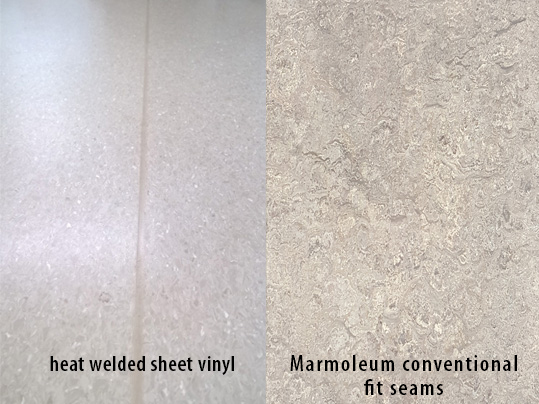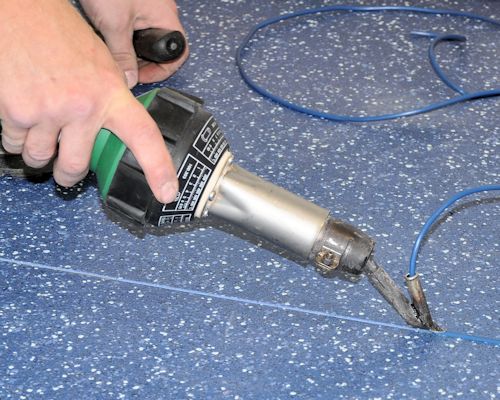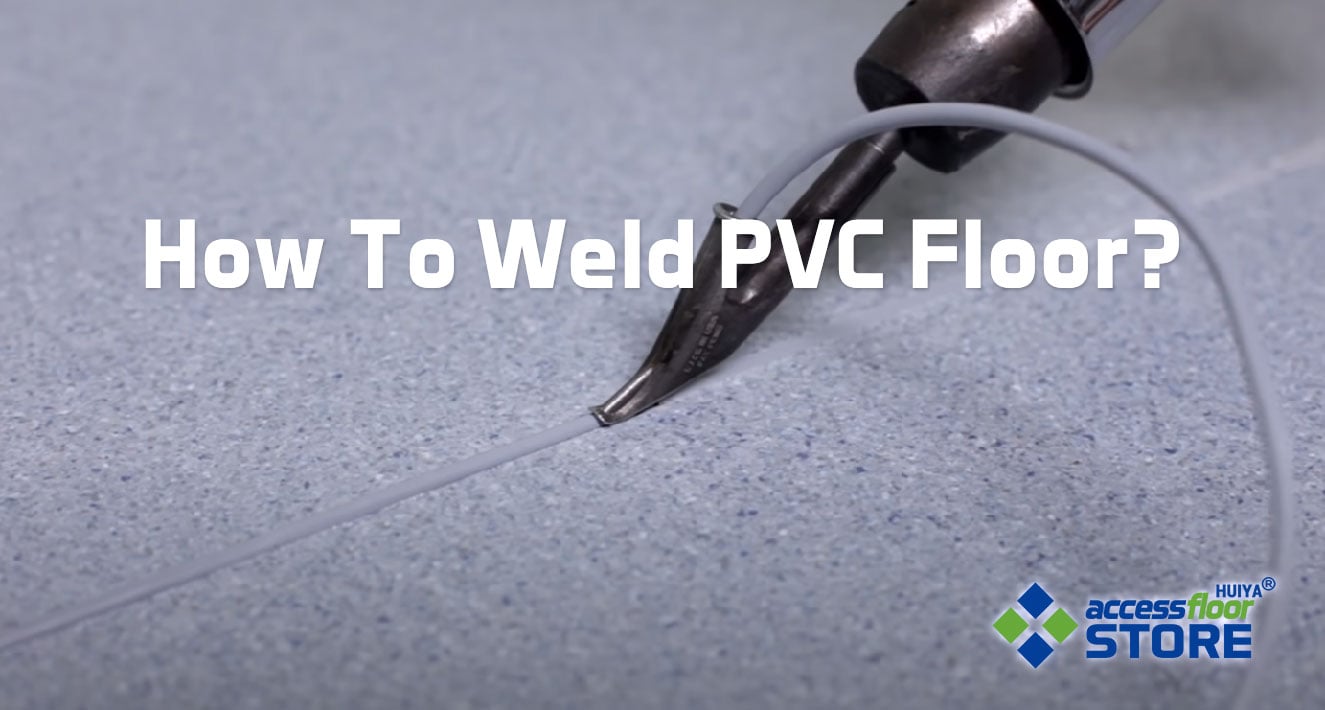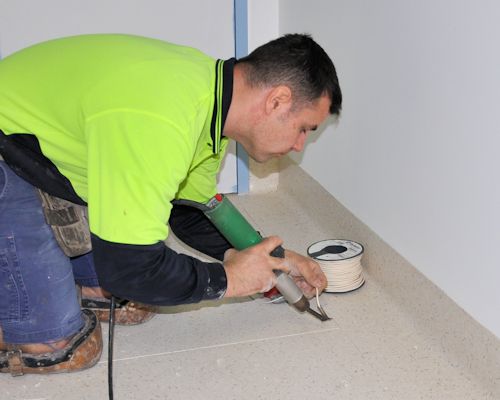Introduction to Heat Welded Vinyl Flooring
Heat welded vinyl flooring, also known as heat-seamable vinyl flooring or homogeneous vinyl flooring, is a type of resilient flooring that is gaining popularity in both commercial and residential settings. Unlike traditional vinyl flooring, which is typically installed with adhesive or glue, heat welded vinyl flooring is welded together at the seams using heat and pressure, creating a seamless and watertight bond. Let’s discuss the basics of heat welded vinyl flooring, including its composition, benefits, and applications.
- Composition: Heat welded vinyl flooring is composed of multiple layers, each serving a specific purpose to enhance the durability and performance of the flooring. The top layer, or wear layer, is made of PVC (polyvinyl chloride) and is designed to resist scratches, stains, and wear from foot traffic. Beneath the wear layer is the print layer, which contains the decorative pattern or design of the flooring. Below the print layer is the core layer, which provides stability and support to the flooring. Finally, the backing layer, or base layer, adds strength and resilience to the flooring and helps to prevent moisture infiltration.
- Seamless Installation: One of the key features of heat welded vinyl flooring is its seamless installation method. Unlike traditional vinyl flooring, which may have visible seams where the individual tiles or planks meet, heat welded vinyl flooring is installed in large sheets or rolls and welded together at the seams using heat and pressure. This creates a completely seamless and watertight surface that is resistant to moisture, making it ideal for use in wet areas such as bathrooms, kitchens, and laundry rooms.
- Durability and Longevity: Heat welded vinyl flooring is known for its durability and longevity, making it a popular choice for high-traffic commercial spaces such as hospitals, schools, and retail stores. The combination of multiple layers and the seamless installation method results in a flooring product that is resistant to scratches, stains, and wear from foot traffic. Additionally, heat welded vinyl flooring is easy to clean and maintain, requiring only regular sweeping and occasional mopping to keep it looking its best.
- Design Options: Despite its practical benefits, heat welded vinyl flooring also offers a wide range of design options to suit any aesthetic preference. From classic wood and stone designs to bold colors and patterns, there is a heat welded vinyl flooring option to complement any decor style. Additionally, some manufacturers offer custom design options, allowing you to create a truly unique and personalized flooring solution for your space.
- Environmental Considerations: Many heat welded vinyl flooring products are made with environmentally friendly materials and manufacturing processes, making them a sustainable choice for eco-conscious consumers. Look for products that are certified by third-party organizations such as the FloorScore program, which evaluates flooring products for indoor air quality and environmental responsibility. Additionally, some manufacturers offer recycling programs for old or worn-out vinyl flooring, further reducing the environmental impact of the product.

Advantages of Heat Welded Vinyl Flooring
Heat welded vinyl flooring offers several advantages over traditional vinyl flooring options, making it a popular choice for both commercial and residential applications. From its seamless installation method to its durability and design versatility, heat welded vinyl flooring provides numerous benefits that make it an attractive flooring option. Here are some of the advantages of heat welded vinyl flooring and why it may be the right choice for your next flooring project.
Seamless Installation: Perhaps the most significant advantage of heat welded vinyl flooring is its seamless installation method. Unlike traditional vinyl flooring, which may have visible seams where the individual tiles or planks meet, heat welded vinyl flooring is installed in large sheets or rolls and welded together at the seams using heat and pressure. This creates a completely seamless and watertight surface that is resistant to moisture and ideal for wet areas such as bathrooms, kitchens, and laundry rooms.
Durability and Longevity: Heat welded vinyl flooring is known for its durability and longevity, making it a popular choice for high-traffic commercial spaces such as hospitals, schools, and retail stores. The combination of multiple layers and the seamless installation method results in a flooring product that is resistant to scratches, stains, and wear from foot traffic. Additionally, heat welded vinyl flooring is easy to clean and maintain, requiring only regular sweeping and occasional mopping to keep it looking its best.
Design Versatility: Despite its practical benefits, heat welded vinyl flooring also offers a wide range of design options to suit any aesthetic preference. From classic wood and stone designs to bold colors and patterns, there is a heat welded vinyl flooring option to complement any decor style. Additionally, some manufacturers offer custom design options, allowing you to create a truly unique and personalized flooring solution for your space.
Moisture Resistance: Heat welded vinyl flooring is highly resistant to moisture, making it an ideal choice for areas prone to spills, splashes, and humidity. Unlike hardwood flooring, which can warp and swell when exposed to moisture, heat welded vinyl flooring remains stable and unaffected by water. This makes it an excellent choice for kitchens, bathrooms, basements, and other areas where moisture levels may be a concern.
Easy Maintenance: Another advantage of heat welded vinyl flooring is its ease of maintenance. Unlike carpeting, which requires regular vacuuming and deep cleaning to remove dirt and stains, heat welded vinyl flooring is easy to clean and maintain. Simply sweep or vacuum the floor regularly to remove dust and debris, and mop with a mild detergent or vinyl floor cleaner as needed to keep it looking its best. Additionally, heat welded vinyl flooring is resistant to stains and spills, making it an excellent choice for homes with children or pets.
Installation Process of Heat Welded Vinyl Flooring
The installation process of heat welded vinyl flooring requires precision and expertise to achieve a seamless and professional result. Unlike traditional vinyl flooring, which is typically installed with adhesive or glue, heat welded vinyl flooring is welded together at the seams using heat and pressure, creating a seamless and watertight bond. Below we provide a step-by-step guide to help you understand the installation process of heat welded vinyl flooring and ensure a successful and long-lasting result.
Surface Preparation: Before installing heat welded vinyl flooring, it’s essential to prepare the subfloor properly to ensure a smooth and stable surface for the flooring. Start by removing any existing flooring material, such as carpet, tile, or hardwood, and thoroughly clean the subfloor to remove dust, dirt, and debris. Repair any cracks, holes, or uneven areas in the subfloor, and ensure that it is dry and free of moisture before proceeding with the installation.
Acclimate the Flooring: Acclimate the heat welded vinyl flooring to the installation environment by storing it in the room where it will be installed for at least 48 hours before installation. This allows the flooring material to adjust to the temperature and humidity of the space, reducing the risk of expansion or contraction after installation.
Layout and Planning: Plan the layout of the heat welded vinyl flooring to ensure proper alignment and placement of the flooring sheets or rolls. Measure the dimensions of the room and calculate the amount of flooring material needed, taking into account any cuts or adjustments that may be necessary to fit around obstacles such as doorways, cabinets, or fixtures. Consider the direction of the flooring pattern and the location of seams to achieve the desired look and feel for the space.
Adhesive Application: Apply adhesive to the subfloor using a trowel or roller, following the manufacturer’s instructions for the specific type of adhesive used. Work in small sections to ensure that the adhesive remains tacky and does not dry out before the flooring is installed. Be sure to apply adhesive to the entire surface of the subfloor, including the edges and corners, to ensure a secure bond with the flooring material.
Installation of Flooring: Roll out the heat welded vinyl flooring sheets or rolls onto the adhesive-covered subfloor, starting at one end of the room and working your way towards the opposite end. Use a roller or squeegee to smooth out any air bubbles or wrinkles in the flooring material and ensure proper adhesion to the subfloor. Butt the edges of the flooring sheets or rolls together tightly to create a seamless surface, and use a heat welding tool to weld the seams together using heat and pressure.
Finishing Touches: Once the heat welded vinyl flooring is installed and the seams are welded together, trim any excess material from the edges of the flooring using a utility knife or straight edge. Install baseboards or molding around the perimeter of the room to cover the edges of the flooring and create a finished look. Allow the adhesive to cure for the recommended period before walking or placing furniture on the flooring surface.
Maintenance and Care Tips
Proper maintenance and care are essential for preserving the beauty, functionality, and longevity of heat welded vinyl flooring. From routine cleaning and inspections to addressing minor issues promptly, several maintenance tasks can help keep your heat welded vinyl flooring looking its best for years to come. Below are some maintenance and care tips to help you maintain your heat welded vinyl flooring and extend its lifespan.
Regular Cleaning: Establish a regular cleaning routine to remove dust, dirt, and debris from the surface of your heat welded vinyl flooring. Sweep or vacuum the floor regularly to remove loose dirt and debris, and mop with a mild detergent or vinyl floor cleaner as needed to remove stains and spills. Avoid using abrasive cleaners or harsh chemicals that can damage the surface of the flooring, and rinse thoroughly with clean water to remove any residue.
Preventative Maintenance: Take steps to prevent damage to your heat welded vinyl flooring by using protective mats or rugs in high-traffic areas, such as entryways, hallways, and kitchen work areas. Place felt pads or coasters under heavy furniture legs to prevent scratching and indentation of the flooring surface. Additionally, avoid dragging heavy or sharp objects across the floor, as this can cause scratches or gouges that are difficult to repair.
Address Spills Promptly: Spills and stains should be addressed promptly to prevent them from setting into the floor surface and causing permanent damage. Use a clean cloth or paper towel to blot up spills immediately, and gently scrub the affected area with a mild detergent or vinyl floor cleaner to lift away any remaining residue. Avoid using bleach or harsh chemicals on the floor, as these can cause discoloration or damage to the surface.
Avoid Excessive Moisture: While heat welded vinyl flooring is highly resistant to moisture, it’s essential to avoid excessive exposure to water or moisture, as this can cause damage to the flooring over time. Wipe up spills and splashes promptly, and use a moisture barrier or waterproof underlayment in areas prone to moisture, such as bathrooms, kitchens, and laundry rooms. Additionally, use caution when mopping the floor, and avoid soaking the flooring surface with excess water.
Regular Inspections: Periodically inspect your heat welded vinyl flooring for any signs of damage, such as scratches, tears, or lifting seams. Address any minor issues promptly to prevent them from worsening over time and compromising the integrity of the flooring. If you notice any significant damage or defects, contact a professional flooring installer or manufacturer for repair or replacement options.
Professional Maintenance: For deep cleaning and maintenance of your heat welded vinyl flooring, consider hiring a professional flooring contractor or cleaning service. Professional cleaning can help remove stubborn stains, restore the shine and luster of the flooring surface, and extend the lifespan of your heat welded vinyl flooring. Be sure to follow the manufacturer’s recommendations for professional maintenance and consult with a qualified professional for best results.
Applications and Considerations for Heat Welded Vinyl Flooring
Heat welded vinyl flooring is a versatile and practical flooring solution that is suitable for a wide range of applications in both commercial and residential settings. From healthcare facilities to retail stores to residential kitchens, heat welded vinyl flooring offers numerous benefits that make it an attractive choice for any space. Here are some common applications and considerations for heat welded vinyl flooring and how it can enhance the aesthetics and functionality of your space.
Commercial Settings: Heat welded vinyl flooring is widely used in commercial settings such as hospitals, schools, retail stores, and office buildings, where durability, hygiene, and ease of maintenance are essential. In healthcare facilities, heat welded vinyl flooring is preferred for its seamless and watertight installation method, which prevents the growth of bacteria and mold in areas prone to moisture. In retail stores and office buildings, heat welded vinyl flooring offers a durable and attractive flooring solution that can withstand heavy foot traffic and frequent cleaning.
Healthcare Facilities: Healthcare facilities such as hospitals, clinics, and nursing homes require hygienic flooring materials, easy to clean, and resistant to moisture and chemicals. Heat welded vinyl flooring is an ideal choice for healthcare settings, as it offers a seamless and watertight surface that prevents the growth of bacteria and mold. Additionally, heat welded vinyl flooring is resistant to stains, scratches, and wear from heavy foot traffic, making it suitable for use in patient rooms, operating rooms, and other high-traffic areas.
Educational Facilities: Educational facilities such as schools, colleges, and universities require flooring materials that can withstand heavy foot traffic, frequent cleaning, and occasional spills. Heat welded vinyl flooring is an excellent choice for educational settings, as it offers durability, easy maintenance, and a wide range of design options to suit any aesthetic preference. Additionally, heat welded vinyl flooring is resistant to stains, scratches, and wear from desks, chairs, and other classroom furniture, making it an ideal flooring solution for classrooms, hallways, and common areas.
Retail and Hospitality: In retail and hospitality settings such as stores, restaurants, hotels, and entertainment venues, heat welded vinyl flooring offers durability, versatility, and design flexibility. With its seamless installation method and wide range of design options, heat welded vinyl flooring can create a cohesive and attractive flooring solution that enhances the overall aesthetic of the space. Additionally, heat welded vinyl flooring is easy to clean and maintain, making it ideal for high-traffic areas such as entryways, dining areas, and retail floors.
Residential Settings: While heat welded vinyl flooring is commonly used in commercial settings, it is also gaining popularity in residential applications, particularly in areas prone to moisture such as bathrooms, kitchens, and laundry rooms. With its seamless installation method and resistance to moisture and stains, heat welded vinyl flooring offers a practical and durable flooring solution for residential spaces. Additionally, heat welded vinyl flooring is available in a wide range of design options to complement any decor style, making it suitable for use in living rooms, bedrooms, and other areas of the home.
Heat Welding Flooring Seams – Mastering the Fine Art – Floor Consult
Commercial Sheet Vinyl Flooring Installation Northeast Flooring
Commercial vinyl, General laying techniques, The welding process
How To Cold & Heat Welding PVC (Vinyl) Flooring Vinyl Floor Seam
Commercial vinyl, General laying techniques, Heat welding equipment
Flash Cove u2014 Preferred Flooring
Heat Welding Linoleum – ProInstaller Magazine
Heat Welding Flooring Seams – Mastering the Fine Art – Floor Consult
How to: Heat Welding Vinyl Floor with Heat Gun,Hot Air Gun
Related Posts:












